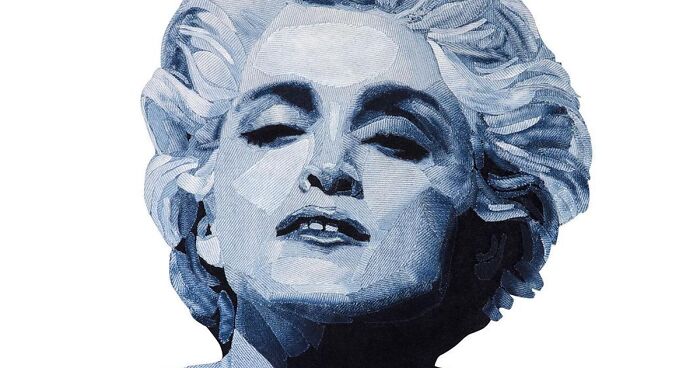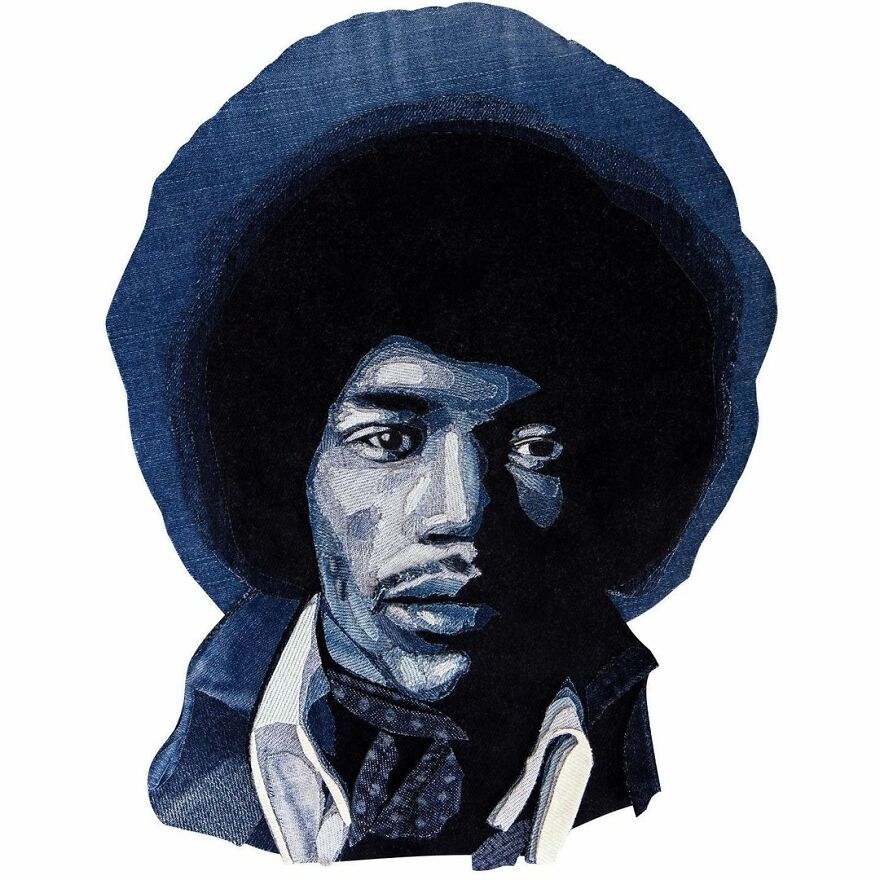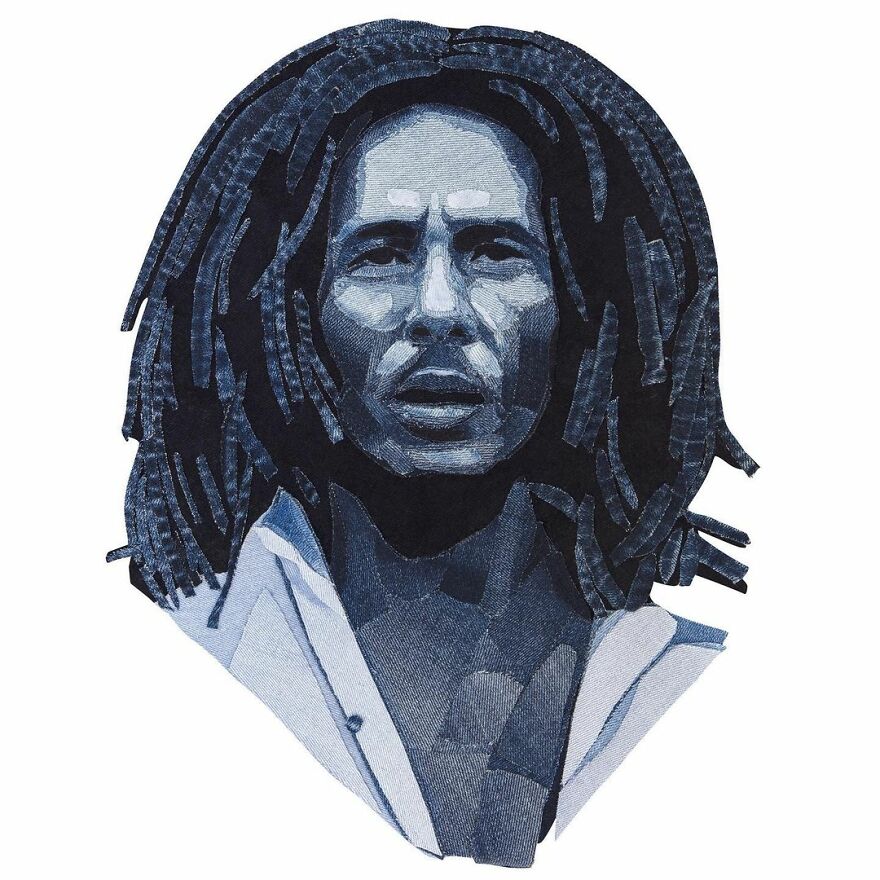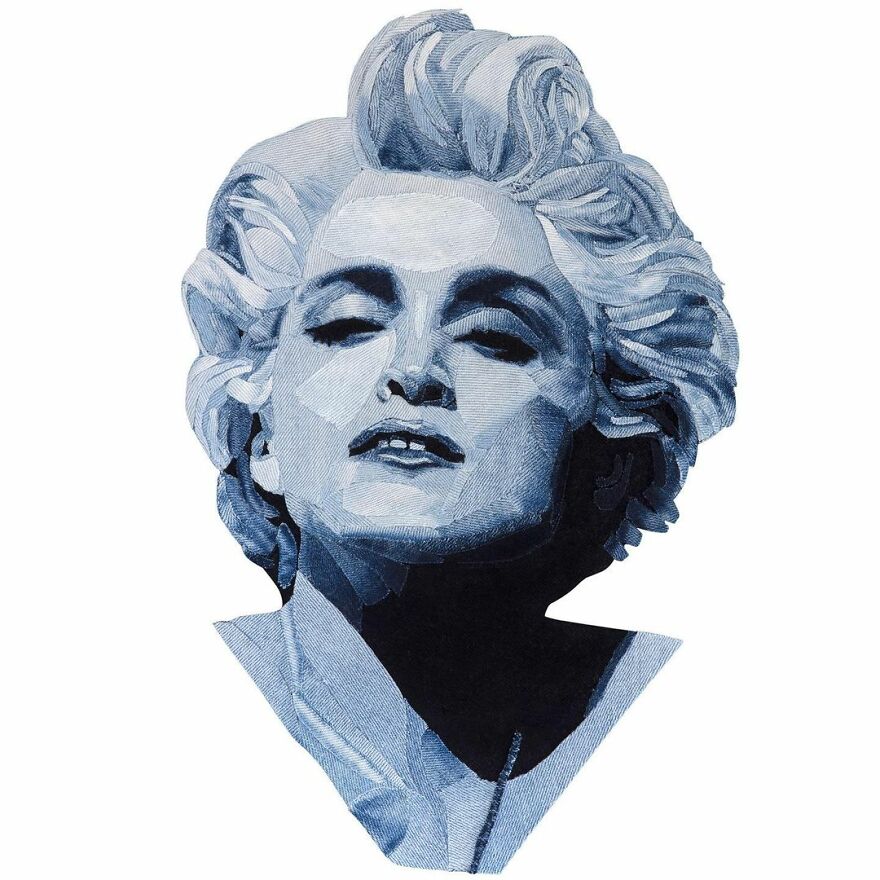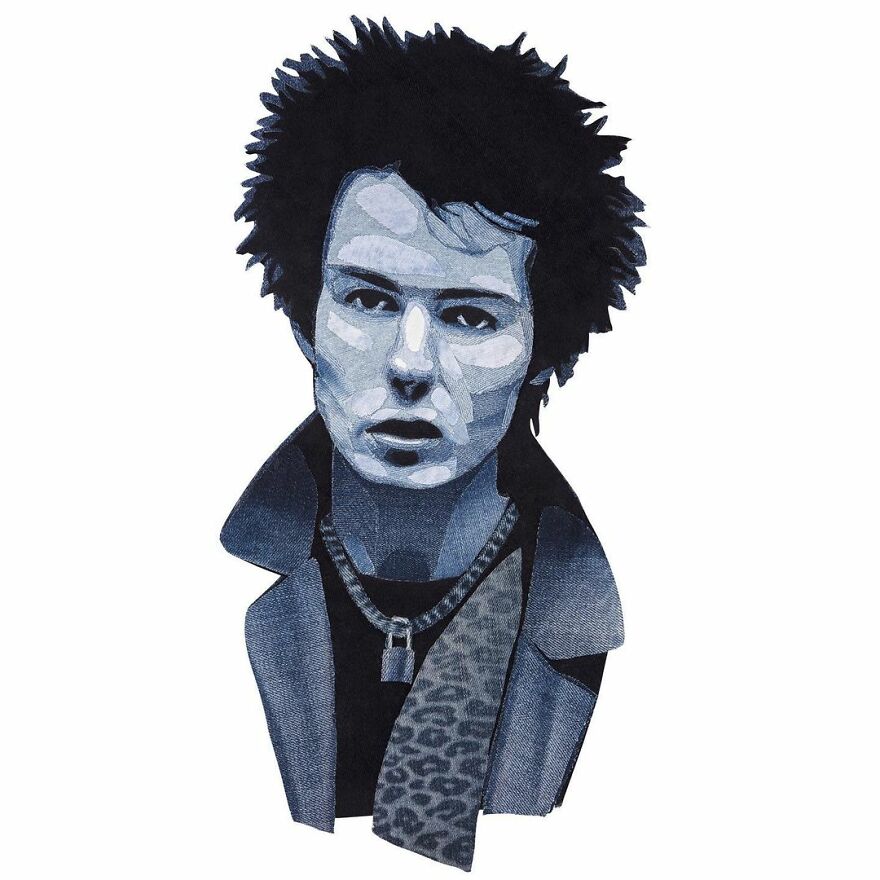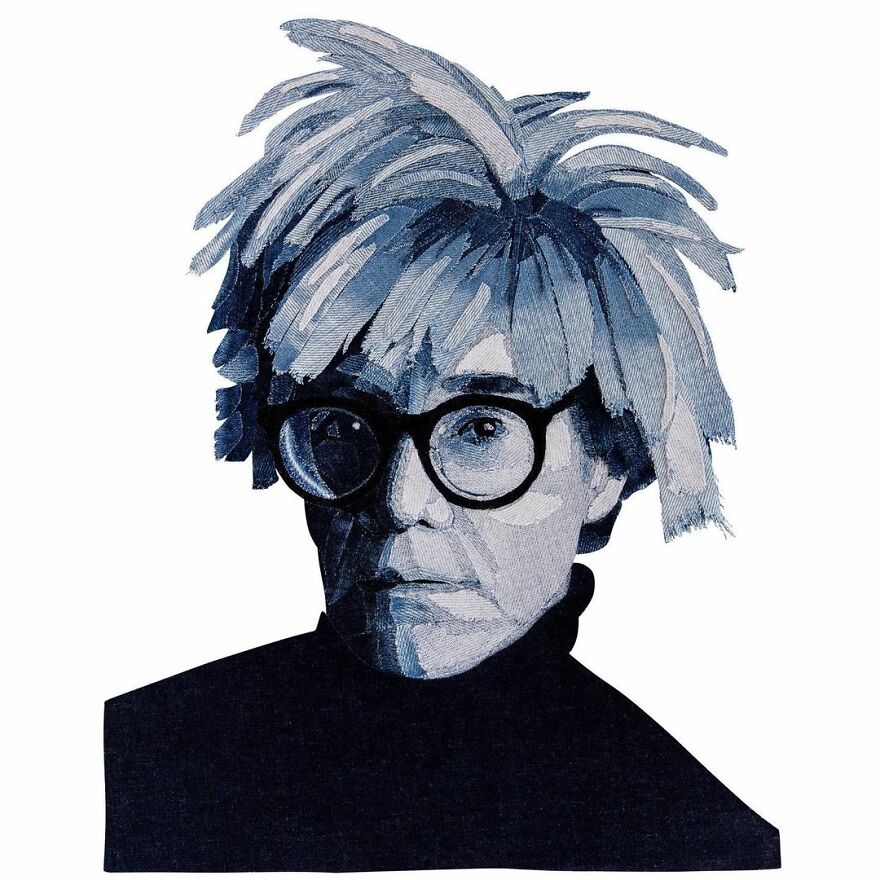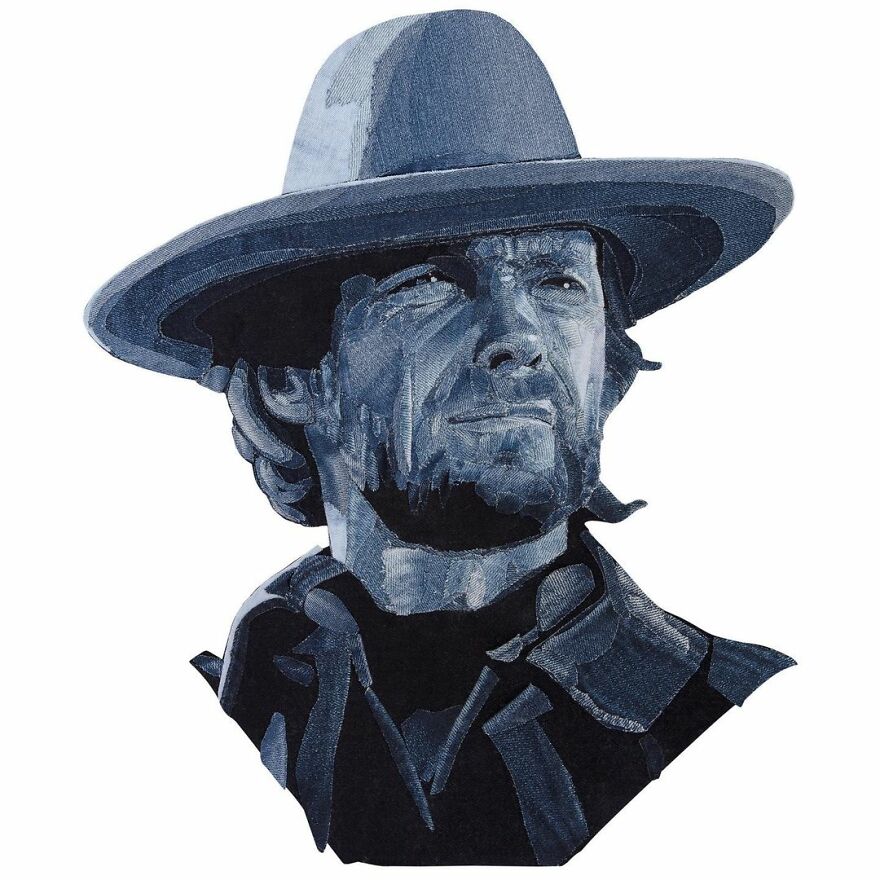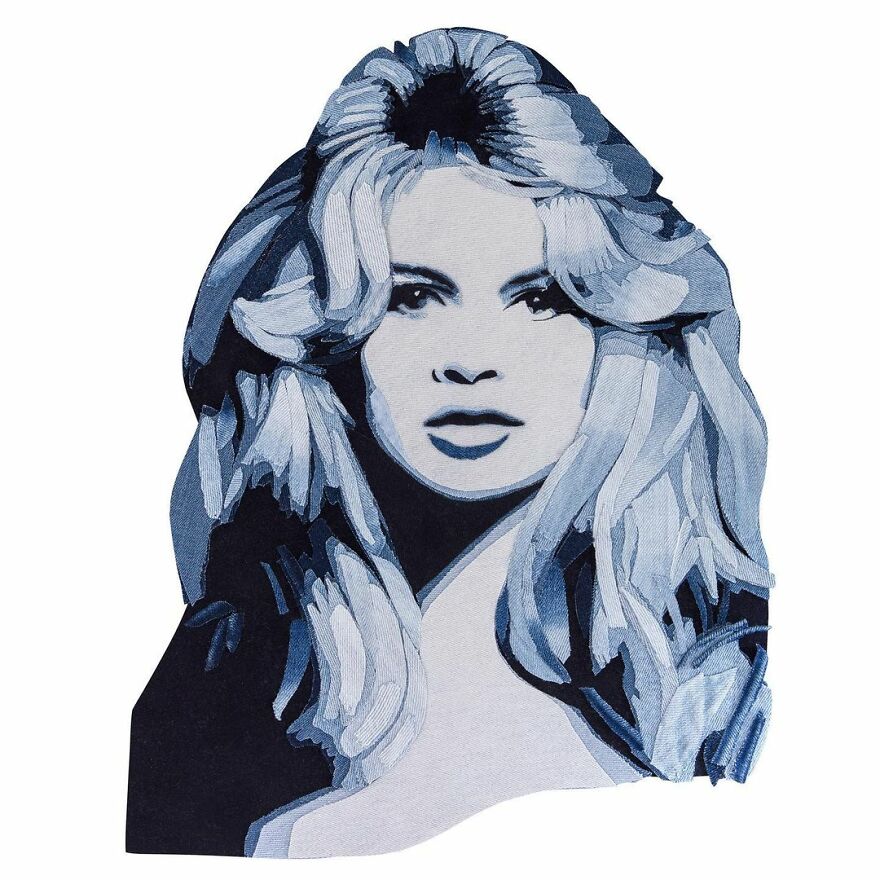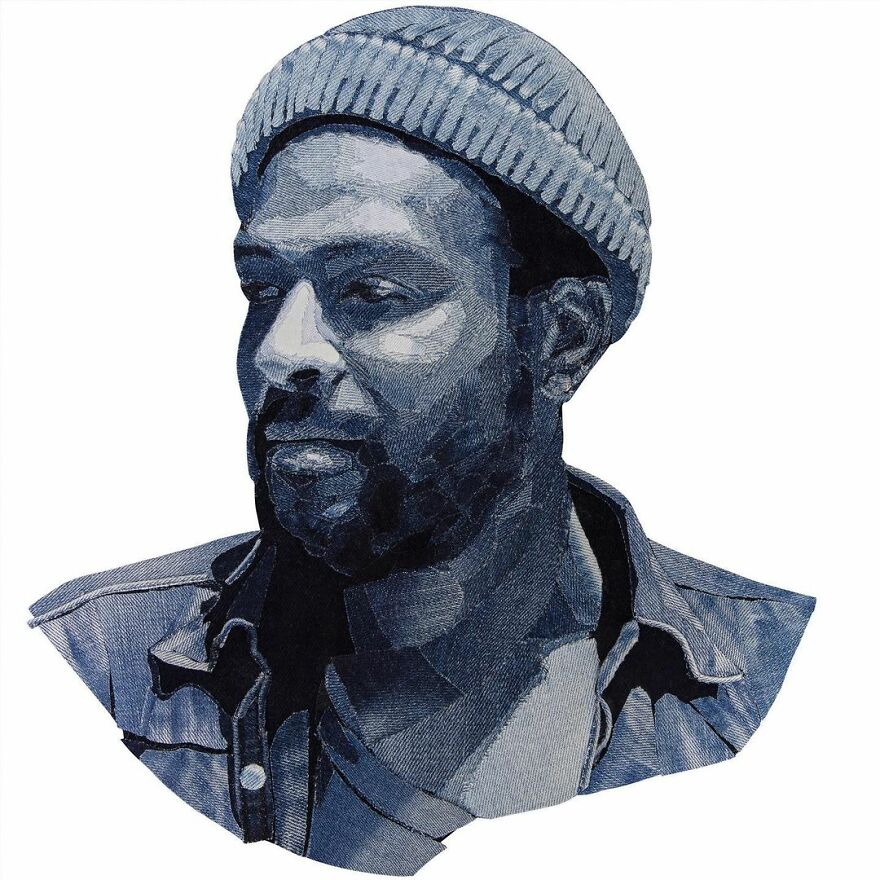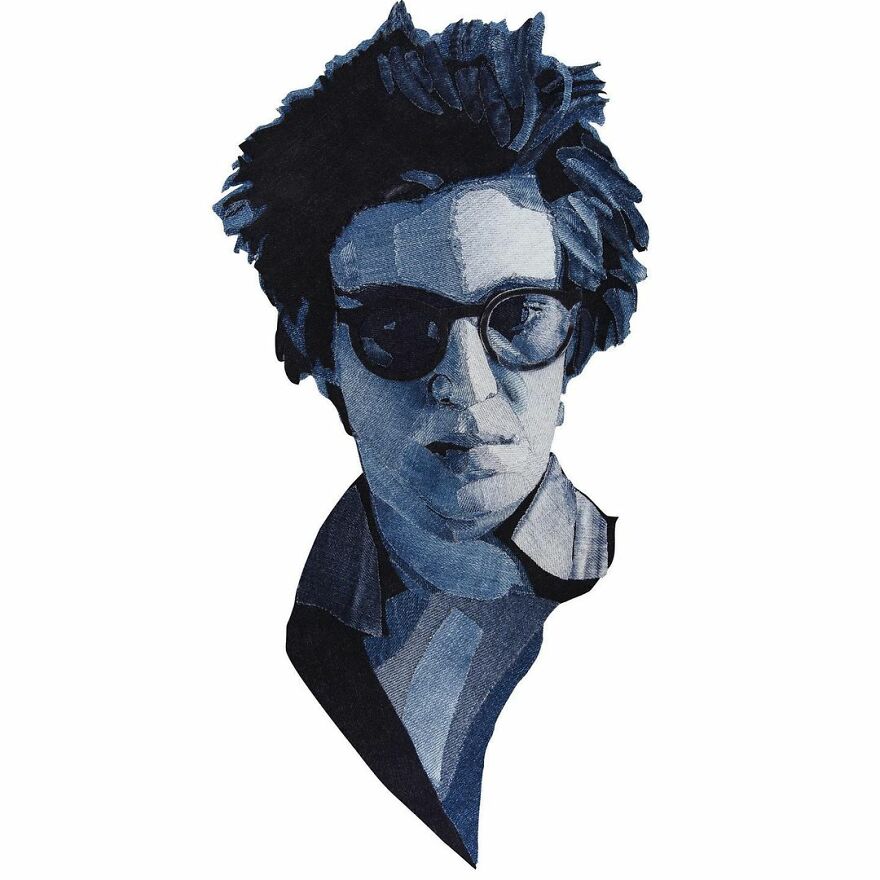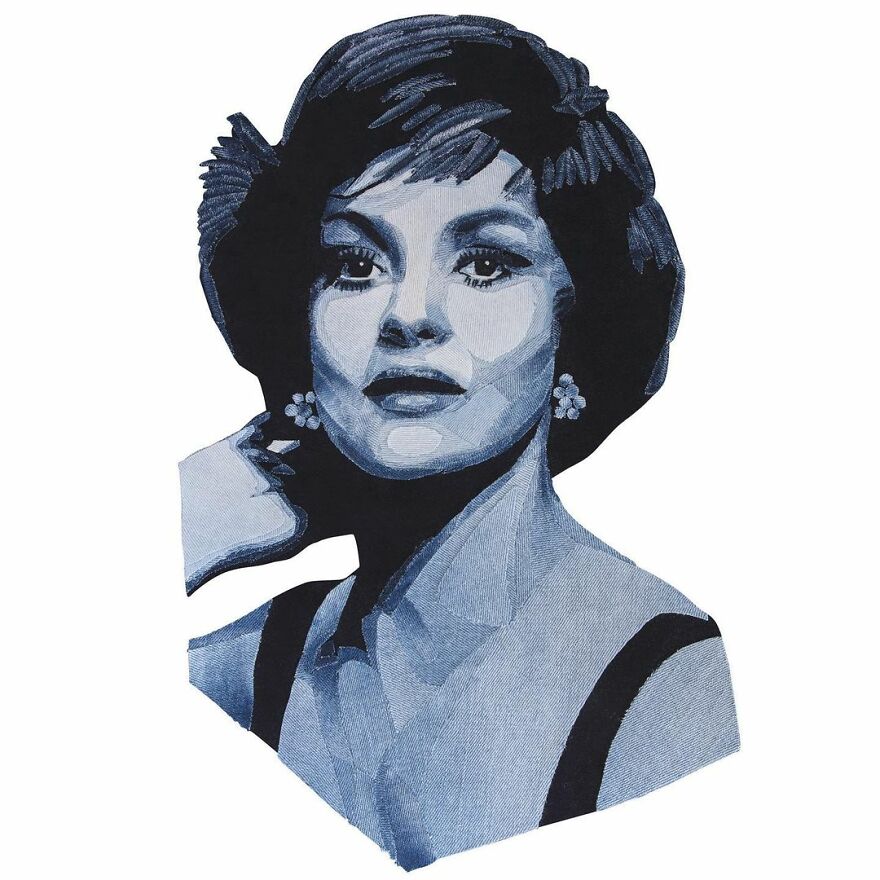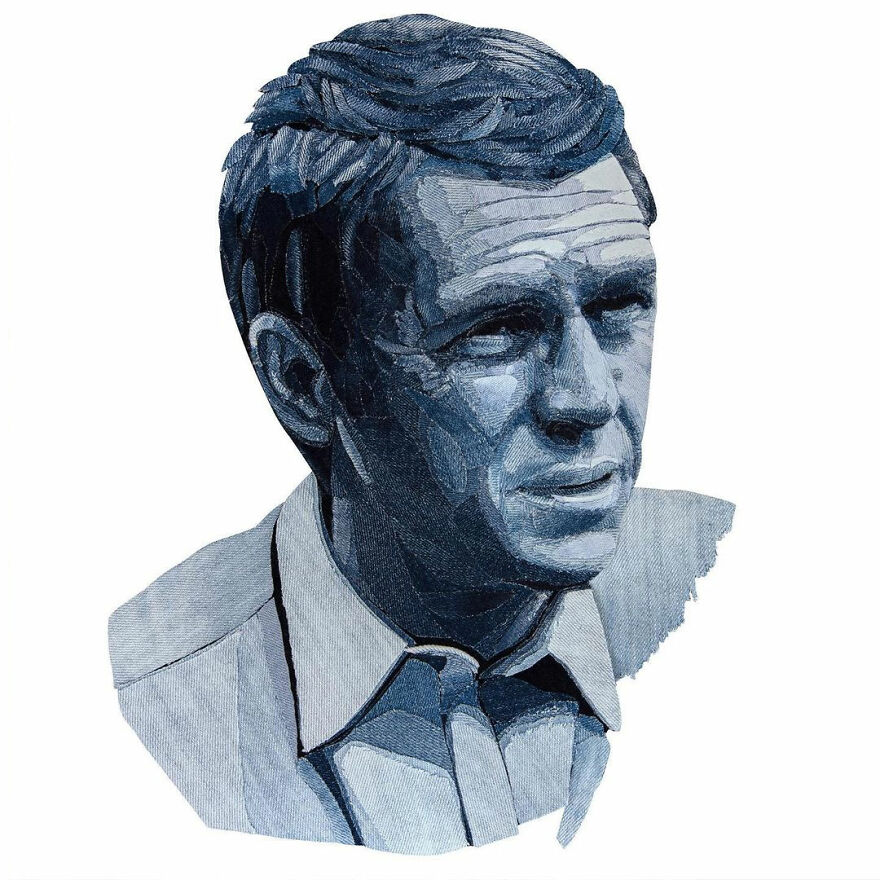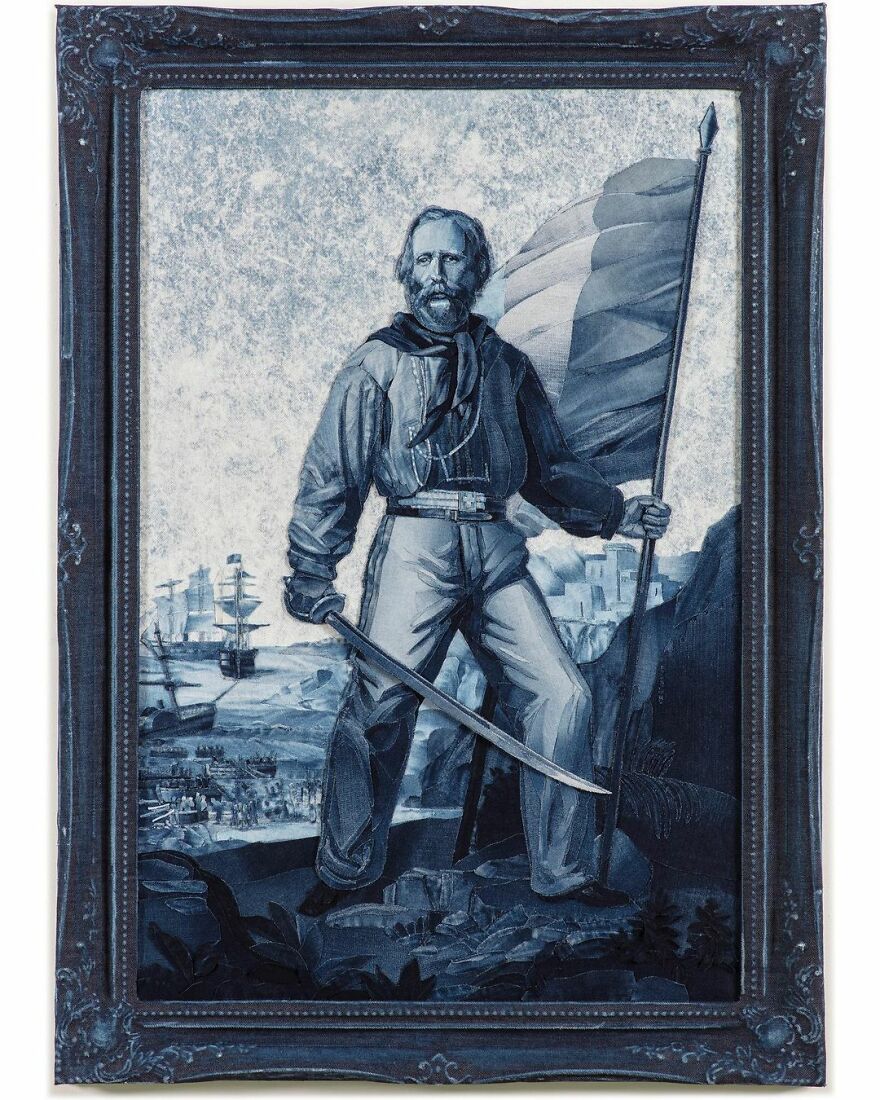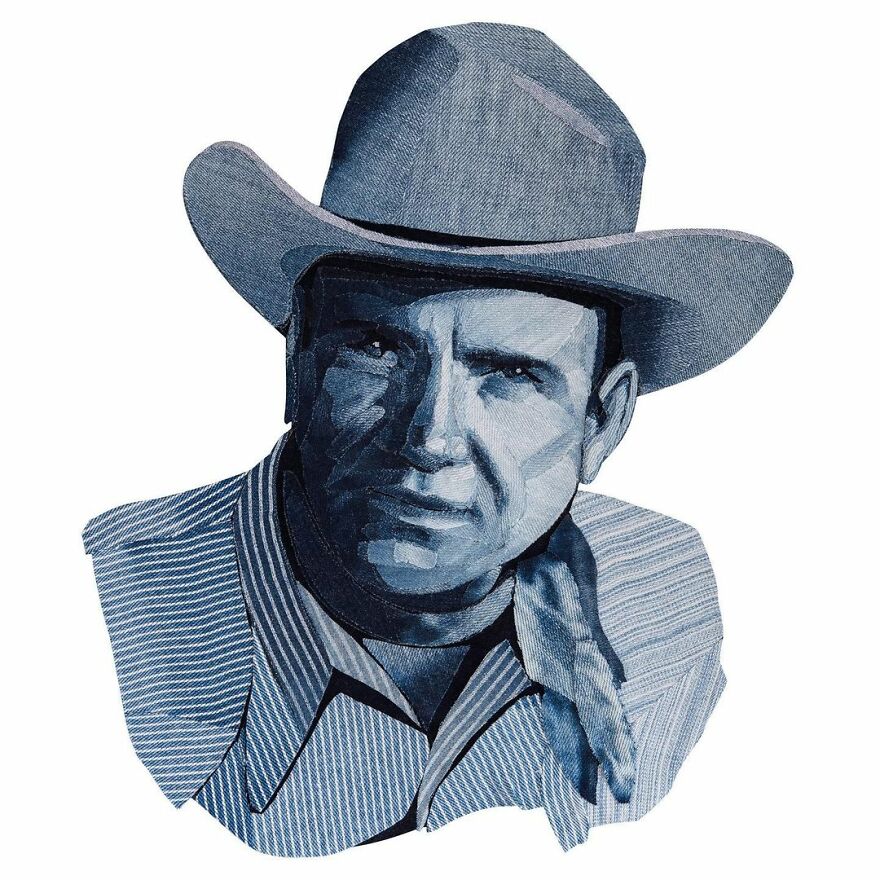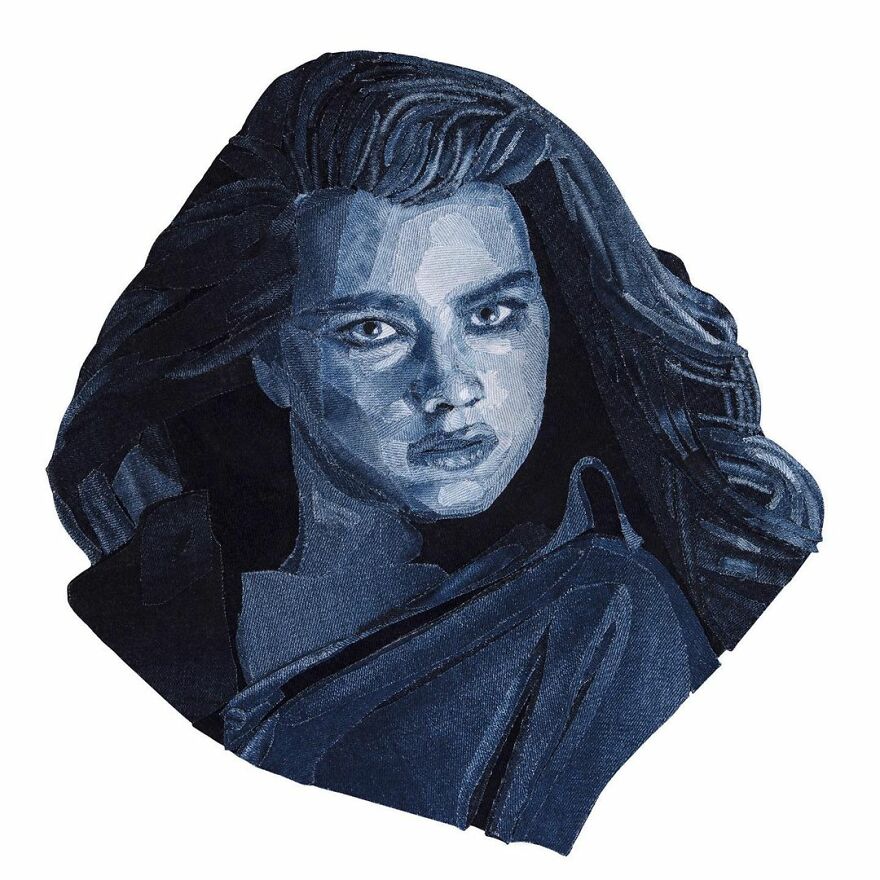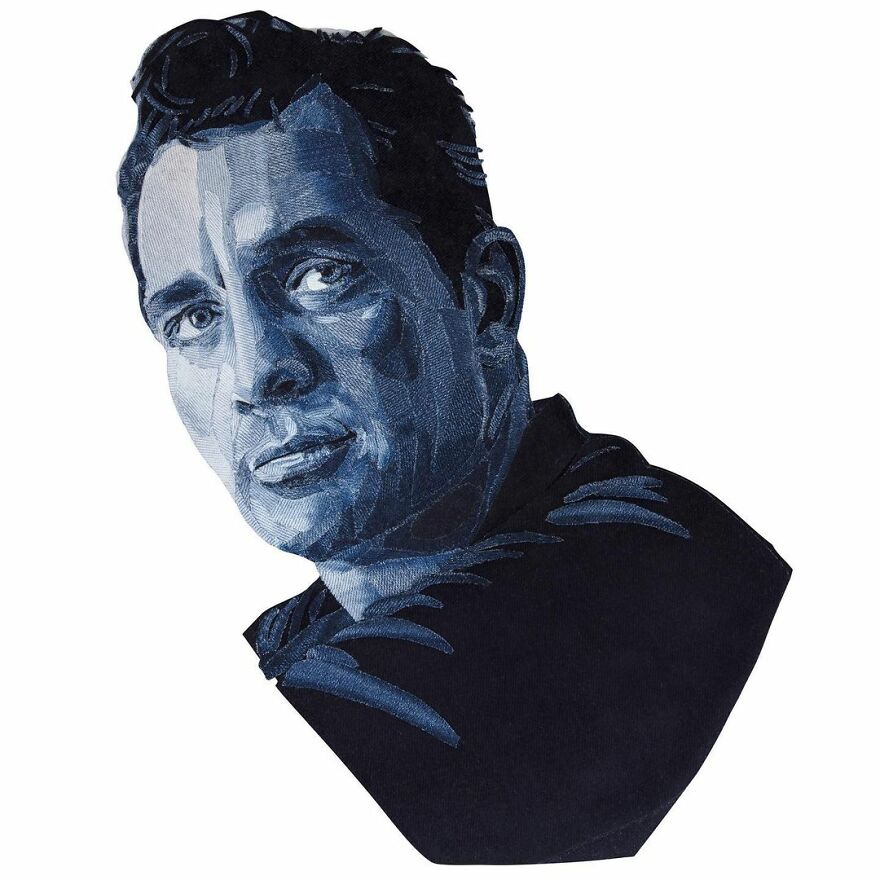Denim was once just a tent fabric, but over the years, it became one of the world's favorite materials to wear. Once used for practical reasons, like sturdiness and longevity, it has become a fashion staple, worn by the coolest personalities of the past century. This latter fact neatly coincides with what this post is about: celebrities in denim, but not in the way you think. It's not a post about celebrities wearing it; actually, it's about celebrities' portraits made in denim. Ian Berry had a fantastic idea, joined famous personalities with the famous fabric, and supplemented it with cool historical facts about them. And the result? You be the judge!
More info: Instagram | ianberry.org | Facebook
This post may include affiliate links.
Jimi Hendrix
"‘There were only two ways to look cool at Woodstock: Wear your jeans or go naked.’
So said Marshall McLuhan, a writer who specialises in North American culture.
As well as fringing, Hendrix wore his jeans with cowboy shirts, frock coats, velvet blazers and balloon-sleeved blouses. I’m sure the kids today will have heard of Hendrix; if not, the look is a little Harry Styles today! Hendrix was an artist to aspire to, more rock star than disco look.
His psychedelic sounds defined an entire era with ear-splitting amplifier feedback. Hendrix was the heart of Woodstock and he remains almost inarguably the best electric guitarist of all time. A fender and god-given talent are never enough to bring fame alone. Without an image, you don’t exist. And there are few who understood that better than Hendrix.
In the days before celebrity stylists and teams of servants, do-it-yourself was the way. Hendrix’s look became progressively brighter and more bell-bottomed as years passed, a slew of accessories — hats, scarves, medallions, brooches, and badges — accompanied him every step of the way."
Bob Marley
"The double denim look may have been a faux pas in the early naughties (who knows if it is now, but I often go triple), but the top-to-bottom denim look of Marley would be timeless. He could wear anything, and it would be cool.
Rocking the same fabric top-to-toe is a time-honoured menswear move. Normally, though, it’s called a suit, the uniform of the establishment stooge come to harsh the good times. Marley’s office demanded a different kind of workwear, so he reached for something as rugged as it was relaxed: denim.
The double denim, the retro sportswear, the unbuttoned shirts and even the occasional pair of leather pants. Bob Marley’s style was a patchwork mix of things that, on paper, really shouldn’t work together but did. Why did they work? Because they were all hanging from Bob Marley, a man whose confidence and relaxed demeanour ensured anything he wore would look like it had been handcrafted just for him.
Marlon James for GQ said in 2016:
‘But by that point his influence was everywhere, and not just musically. His style DNA passed down through punk rockers like the Clash, straight to Bad Brains, Lenny Kravitz, Wyclef Jean, and Gary Clark Jr. When hip-hop went Native Tongues, the rappers looked like Marley children — and when the Marley children grew up, they looked like updates of big papa. He still stands as the most convincing and exciting rock star in a decade chock-full of rock stars, in huge part because he had something to say, but also because he looked so f@cking good saying it.’
As a kid, I went to Marley’s house in Jamaica and I so wanted to buy a tee shirt, my mum refused. I now realise it was the spliff in his hand that made her say so, what an innocent little 10-year-old I was."
Madonna
"Madonna in 1984 was shot wearing a denim jacket back to front. If anyone can rock a denim jacket backwards, it's the Queen of Pop. The jean jacket's popularity as fashionable outerwear skyrockets in the '80s far from its rural and labour roots.
Madonna is of course a living legend so has to be included for the inspiration she gave. With her '80s look and baggy clothes and the general punk vibe, Madonna really made the acid wash and double denim trend come to life!
The Material Girl may be known for many looks, but also many varied denim. There was her cowboy blues in her music video Music from Dolce & Gabbana in 2000. The Queen of Pop has been seen in many denim styles over the years, even combining them with a track suit top, but her patched jeans for the American Pie video during the more hippie, Ray of Light years showed a different side."
Sid Vicious
"Now, we're not here to judge anything other than their impact on denim. Along with designers Vivienne Westwood and Malcolm Maclaren, the Sex Pistols manager, I don't think anyone in the UK had as much impact on punk as them. (welcome to argue the Clash)
Though punk began in New York with The Ramones and New York Dolls, McLaren brought it back to London and with Sex Pistols made the genre a household name.
Sid Vicious, as a person, has many question marks. It's undoubted, however, that in the year he was with The Sex Pistols, he embodied the punk rock lifestyle, and has influenced both fashion designers and consumers ever since.
Whatever you think of the band, they had an impact, and long after the last-ever gig at Ivanhoe's nightclub in my hometown Huddersfield on Christmas Day 1977.
If Sex Pistols are a part of the denim story with ripped jeans and safety pins, is it Sid Vicious or Jonny Rotten, or both?"
Andy Warhol
"Possibly the most well known artist of his day, famous for screen printing ordinary bits of American life in the '70s along with his New York Factory lifestyle.
He may have also been known for his black polo neck, but along with it was his Levi’s – often black.
If this wasn’t enough to make the list, his album cover for Rolling Stones’ Sticky Fingers surely does.
Featuring a photograph of jeans, and the crotch, many of the early ones featuring a real working zipper. To add to this was one of the best quotes about denim ever said...
‘I want to die with my blue jeans on.’
Andy Warhol was featured on the front cover of L’UOMO Vogue ‘Blue Denim Jeans’ special denim edition in 1980 seen wearing double denim, and he, of course, also depicted Elvis in his jeans. Has denim become the very thing he was often portraying then, a mass commodity?"
Clint Eastwood
"Clint brought some of the western genre’s biggest blockbusters to life and became a fashion icon in the process. He embodied rough-and-ready, masculine style like no one else and was a master of rugged textures and coarse fabrics.
Unlike many who you will see portrayed, he is still going strong and as he aged, he still looks better in jeans (and a T-shirt) than guys less than half his age (ahem, me). His style follows his films. He may clean up for the red carpet — but Clint is a head-to-toe denim guy with a 10-gallon hat.
From classic fringed jackets to doubled-up belts, Clint Eastwood’s iconic roles in western films have made him one of the most fashionable actors of all time. Throughout the late '60s, Eastwood turned the John Wayne (the last post) cowboy archetype on its head as an amoral antihero in Sergio Leone’s Dollars trilogy. The Man With No Name was quick to violence, anti-social, and wore tight blue jeans. The Hollywood establishment initially decried the excess of these revisionist “spaghetti” westerns, but their popularity pushed the big studios to produce equally violent films.
Ironically, in one of his most famous roles, he would also play the reactionary antithesis to jeans-wearing outsiders as police inspector Dirty Harry (1971). His wardrobe consisted of tweed and khakis and he was willing to overstep the law if it meant bringing punks like the Scorpio killer to justice. Scorpio, you guessed it, was the jeans and work boots type."
Brigitte Bardot
"Brigitte Bardot is still one of France's biggest names and the gap-toothed ‘Sex Kitten’ was frequently seen in a pair of 501s for press appearances or star-studded parties. A star in '50s movies after beginning to model as a 15-year-old in 1949, she helped to change jeans from their army image and become the new sexy trend with an army of followers.
In stylish France, not all were happy. She was once stopped in the street and shouted at. Ironically, by today’s standards, it was a woman in a FUR COAT who spat in her face and screamed ‘You’re undermining the Bourgeoise’.
Levi’s first major European market was not the UK, as you may expect, but France, and I wonder how much that was down to Bardot helping it become a mainstay of middle-class informality. Of course, France had a history with the fabric and the name come from Serge de Nimes – once having the English treatment… to denim."
Marvin Gaye
"During his earlier performances, particularly earlier in his career, the legendary star was a consummate professional, wearing smart suits. In 1961, he had begun his path at Motown Records, quickly rising to become “The Prince of Motown” as the label's top-selling male solo artist during the 1960s.
Motown Records had a strict formula for the assembly-line pop songs. Founder Berry Gordy strictly avoided politics, focusing on the traditional staple of love and romance. Gaye had other ideas. He was an outspoken artist who wanted to tackle race, police brutality and the injustice of the Vietnam War in his lyrics. He said:
“In 1969 or 1970, I began to re-evaluate my whole concept of what I wanted my music to say. I was very much affected by letters my brother was sending me from Vietnam, as well as the social situation here at home. I realised that I had to put my own fantasies behind me if I wanted to write songs that would reach the souls of people. I wanted them to take a look at what was happening in the world."
What’s Going On was Gaye’s political album, recorded with the statement of him wearing jeans and smoking dope — both radical statements at the time. African American performers had previously linked denim with sharecropping and poverty. It would go on behind Gordy’s watch and he later described the single as “the worst thing I ever heard in my life”, before refusing to release it. In an act of defiance and self-belief, Gaye released the song behind Gordy’s back, and in the weeks to come, it became the fastest selling Motown single of the time."
Richard Hell
"One of my favourite parts of this denim story is what happened down in a small New York Bowery bar; CBGB. A melting pot of creativity and raw talent that would congregate and the echoes could be heard around the world. Television was one of the most popular bands on the scene and its frontman, Richard Hell with his cropped short hair and his ripped tee and jeans, it may not seem so now, was a radical new look.
Brit Malcolm Maclaren, then manager of the New York Dolls, would see this look and once back in the UK, would recreate it with the Sex Pistols (posted yesterday) and give birth to what would become punk. Taking Hell’s busted-out knees and safety-pinned, held-together outfits that were almost from necessity to create a whole movement."
Gina Lollobrigida
"Here’s one for the Italians! France has Brigitte Bardot and the equivalent was Gina Lollobrigida, who helped carry the denim wave to Italy and Europe as she was often seen wearing Italian-made pedal pushers.
On the set of Trapeze, she looks effortlessly better than any who have made the effort since in a sleeveless jumper and baggy jeans.
She was one of the highest-profile European actresses of the 1950s and early 1960s, a period in which she was an international sex symbol.
So not a bad person to help push the denim narrative. Wonder how many Instagram followers she would have had today? While Italy has some of the world’s most famous denim designers, does Gina deserve a place in the Top Legends of Pop Culture? What other icons of the era can you think of, and other women of the era?"
Steve Mcqueen
"On a weekend back in ‘06 I made portraits of James Dean, Marilyn Monroe and Marlon Brando. I have cringed sometimes looking back. These overdone faces of these immortal legends. I have noticed many artists who lead the way with using unusual material often hone their technique with similar images before moving on.
But I was going into adland and I was fascinated that they had been seen wearing jeans and others copied, en masse... setting off a chain of events that now make jeans so common, and perhaps even, too, mass.
The history of jeans follows that of pop culture, as well of that of America. As I have pointed out lately with the name of denim (Nimes) and jeans (Genoa) and their respective stories, it was in California with the Gold Rush and Levi Strauss where jeans really started to advance. And much of the success of jeans has been its links to America, freedom, democracy with a touch of rebellion. But what made this hard-working work wear of the miners the stylish street wear of today? Hollywood certainly played its part."
Giuseppe Garibaldi
"Giuseppe Garibaldi would possibly have had the biggest following on Instagram in his day.
You can get followed for both accomplishments and/or looks. He combined both and while he was one of the leading forces in uniting Italy, he did it in a trademark ’communication style’.
While the red shirts and even the poncho became an iconic look, he united Italy and became the ‘Father of the Fatherland’ and the ‘Hero of the Two Worlds’ while wearing what would be known today as jeans. Long before Mr Strauss perfected the look that has become one of the world’s favourite garments.
While born in Nice, he was often based in Genoa, and it was also from here he would set off from the famous port to his many battles.
Genoa, Genova, Genua, Génova, Gênes. What do they say about the favourite child having many names? And this beautiful and historic port city has, and its French name, Blue de Gênes, that talked of the indigo-dyed material that was a precursor to what we now know as jeans (yes, we English named it so!)
Indeed, it’s been fascinating to see the links between Genoa and England, not least the flag of St George. Garibaldi was adored in England & all over the world. More info in the profile link.
It’s been an amazing time getting to know Genoa more, Garibaldi, and also learning more about Italian and denim history and meeting great people.
It’s an honour to show in the museum that celebrates him, Museo del Risorgimento, and has many artefacts, including the red shirts and his trousers. It’s also the home of Mazzini, who also was a driving force in Italy.
My work actually hung next to the first written version of the Italian National anthem — which I heard a little too much this summer.
After many setbacks over several years, it’s great to finally work with the city and launch this piece during @genova_jeans that aims to champion the jeans link and promote a sustainable future."
John Wayne
"Can you imagine a time when jeans weren’t the go-to item in your wardrobe? Have you ever thought of why we all wear this garment that, while rugged and tough, never used to feel good against your skin? Now for many of us, it’s our second skin.
One of the reasons is because of popular culture and the portrayal of them in films. There are more iconic moments and impacts of the denim story upcoming, but one of the first moments in films were those of the western. Jeans are now a must in western wear, but the films in which these guys were portrayed wearing jeans were historically inaccurate. The cowboys of the age depicted didn’t even wear jeans, more a woollen pant. But let’s not let the truth get in the way of a good story, and what would set the scene to making the jean and denim one of the most popular items the world over.
John Wayne, Gene Autry, Roy Rogers, Gary Cooper, and later the likes of Clint Eastwood and Paul Newman romanticised the American West while wearing jeans, and often denim jackets. This would make it the outfit of the cowboy. At this point it was more ‘dress up’ to look like their cowboy heroes, and city guys and gals would wear them to ‘Dude Ranches’ as well as of course, as work wear."
Brooke Shields
Nothing came between 15-year-old Brooke and her Calvin's in the provocative '80s Calvin Klein Jeans press and TV campaign.
Shot and directed by fashion photographer Richard Avedon, the then-shocking ad outraged many, especially when finding out the newcomer Shields was only 15. The spoken tagline will forever be remembered: "You wanna know what comes between me and my Calvin’s? Nothing."
While the ads were wildly controversial, they were hugely successful. More than 2.5 million pair of Calvin Klein jeans were sold the month the ad aired. “Jeans are sex,” Klein explained with a shrug. “The tighter they are, the better they sell.”
Shields would later tell the New York Post that the ads weren’t troubling to her: “The pants came above my belly button — even the one with my shirt open, you didn’t see anything. Compared to the things I’d done before, this was like being in winter gear.”
Jack Kerouac
"'Jack Kerouac foi responsável pela venda de um milhão de pares de jeans com On The Road'
So said writer William Burroughs in 1969. Ironically, at that point, none of the participants in Kerouac’s manifesto of the beat movement wore jeans, published a decade earlier in 1957. But to Burroughs, he had created the new American aesthetic in which the growth of denim became inevitable.
Although he was originally met with criticism and had trouble finding a publisher, he would eventually become the voice of a generation — the Beat Generation.
Taken from a passage in GQ that said of Kerouac: ‘Flower power was all well and good, but Jack Kerouac often wondered aloud how the Beats could’ve given birth to such Technicolor bravura. Kerouac’s look was broken but unbowed — as he once said: “ragged, beatific, beautiful in an ugly graceful new way.“ And yet his aesthetic is everywhere today: That Brooklyn hipster rocking overalls under his Carhartt jacket while reading Hart Crane? That kid in San Francisco sporting scuffed cords and a frayed collar, with Madame Bovary stuffed in his back pocket? They’re paying unwitting tribute to the man who exploded the 1950s world of straight-white pretensions, rejecting the notion that class was synonymous with value.
The Beats presaged the “urban rustic” moment that would happen early in the 21st century that resulted in the resurgence of numerous American legacy brands by melding the high with the low. Kerouac was one of the first cultural icons to master this balance with brooding grace."
